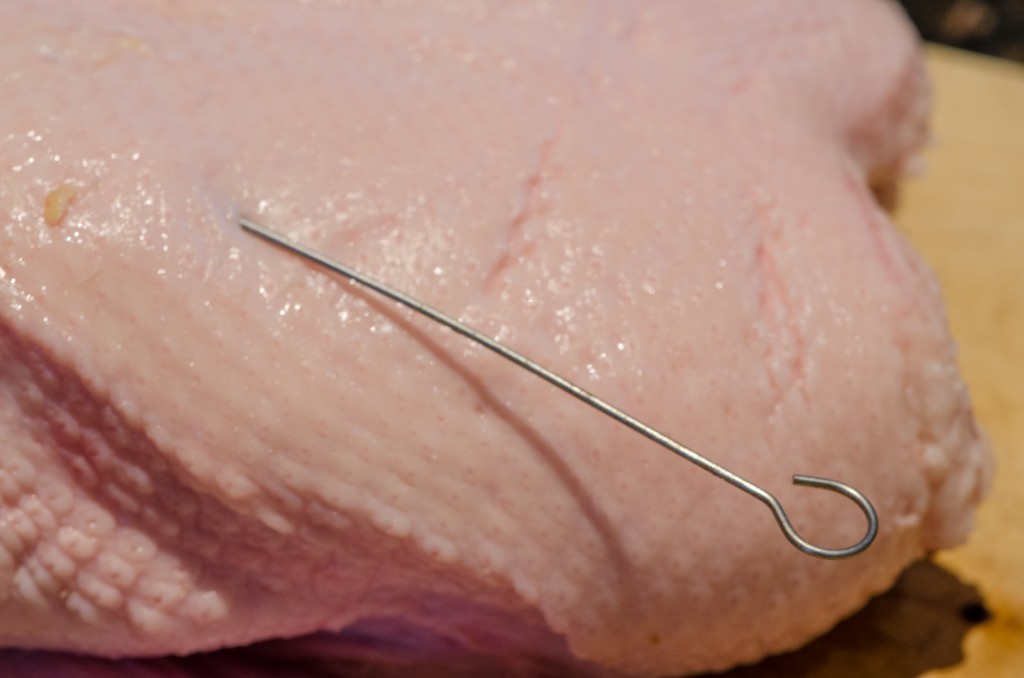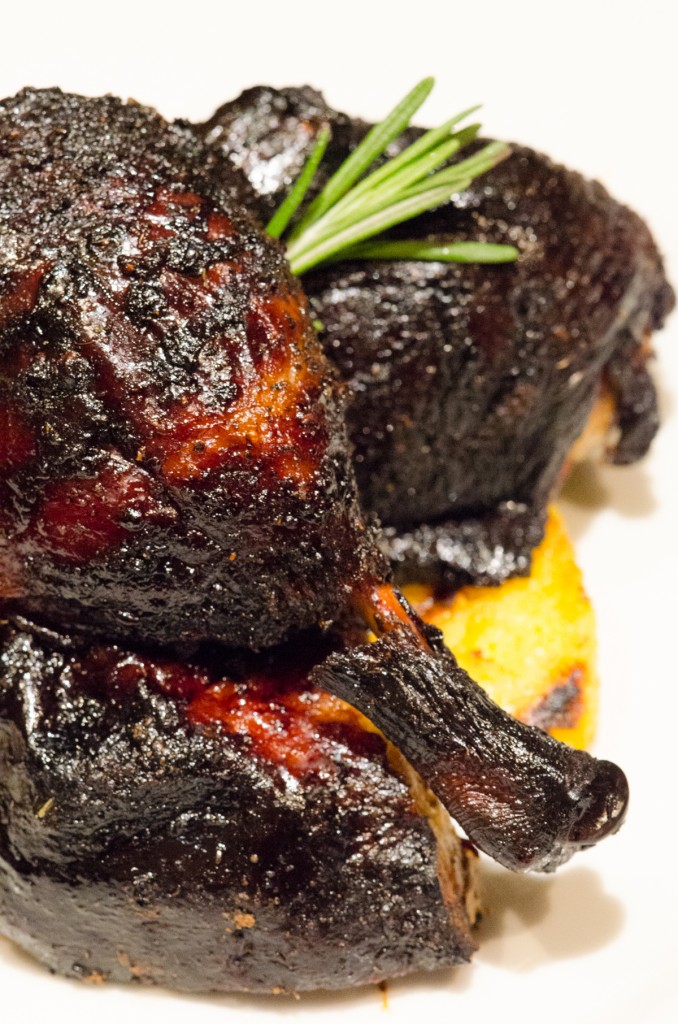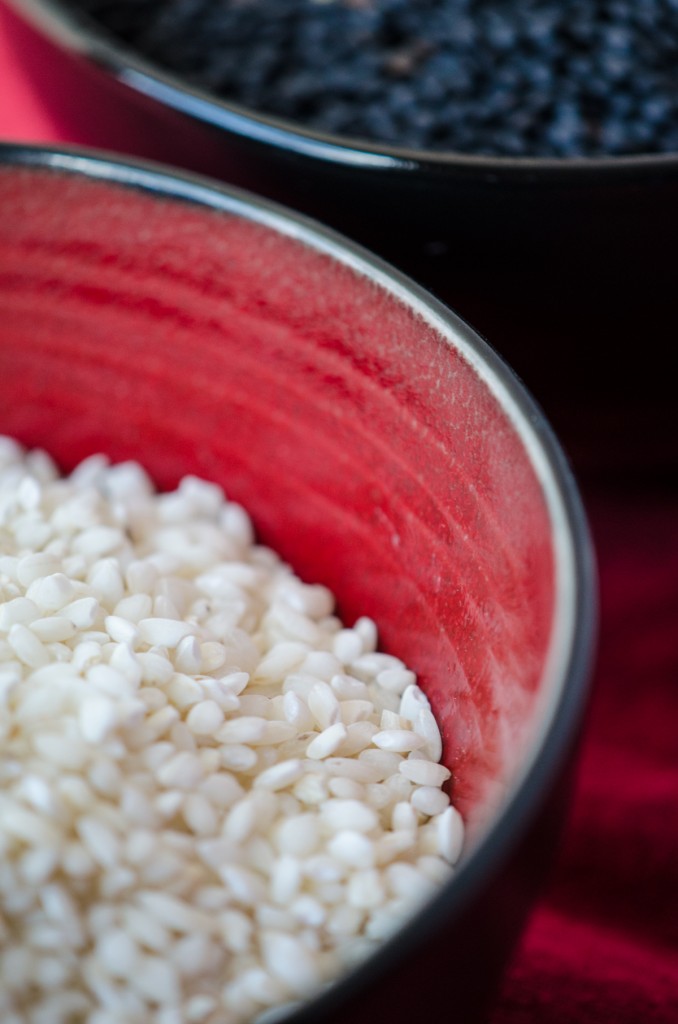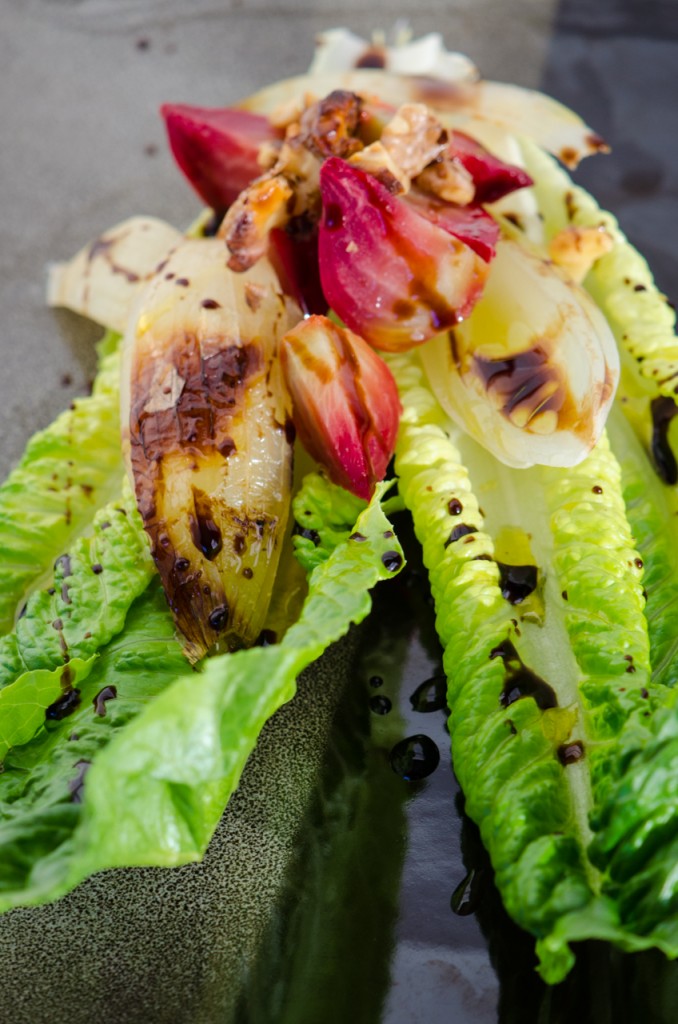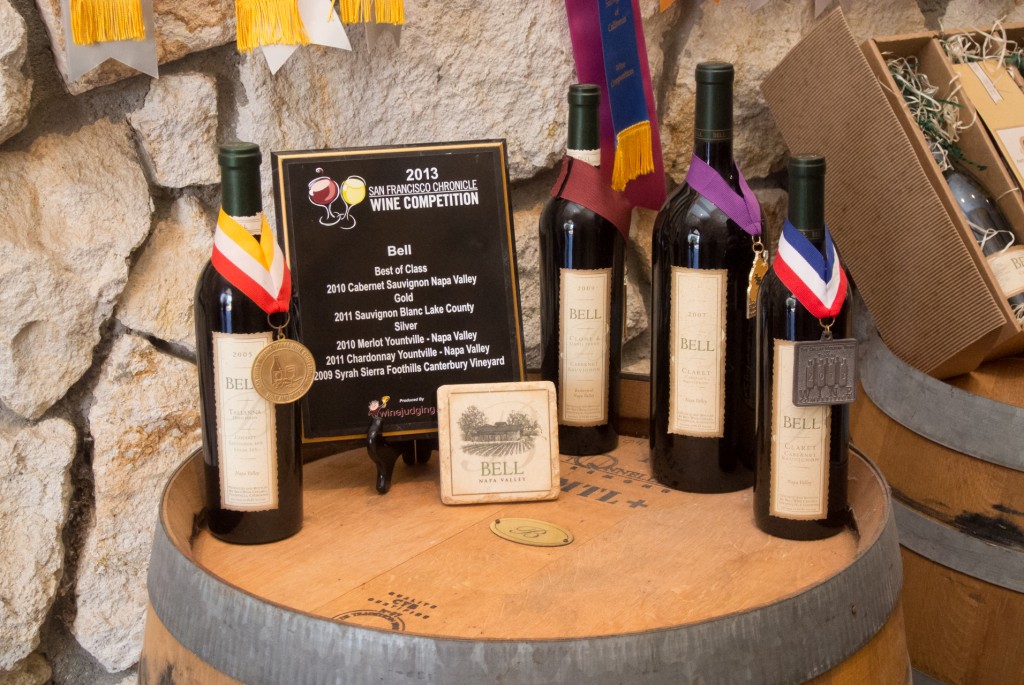 This subject comes up quite often during our Bike the Wine Roads tours through Italy. Usually as we are enjoying a glass of a little-known Italian varietal at a family winery, where they have been producing wine for generations. Why don’t we we see these varietals back in the US? What makes California wines different than the wines we enjoy in Italy – is it the grapes? The production methods? The style of wines? The terroir?
This subject comes up quite often during our Bike the Wine Roads tours through Italy. Usually as we are enjoying a glass of a little-known Italian varietal at a family winery, where they have been producing wine for generations. Why don’t we we see these varietals back in the US? What makes California wines different than the wines we enjoy in Italy – is it the grapes? The production methods? The style of wines? The terroir?
Anatra Arrosto con Balsamico
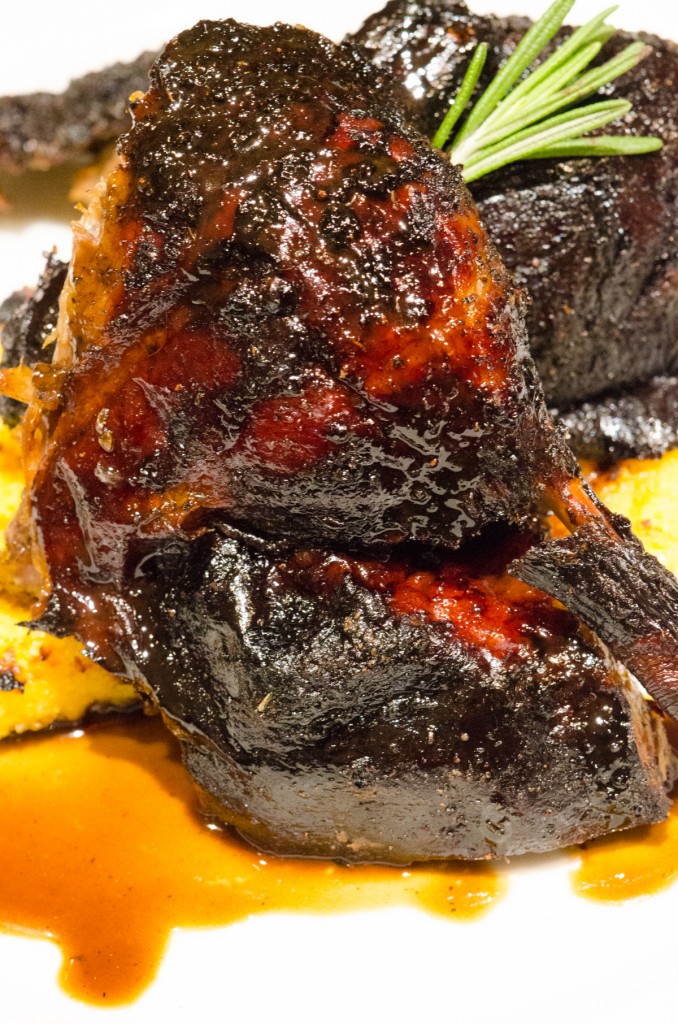 Venetians themselves are not really meat eaters; their watery surroundings naturally drove them to a seafood based cuisine. However, as you move inland from Venice to the mainland, the low-lying wetlands that exist around the Po, Brenta, and Adige river valleys were the perfect breeding ground for a wide variety of waterfowl. Our Italiaoutdoors Food and Wine cycling tours take us along many of these same rivers. These various species of waterfowl were value and hunted by the locals for hundreds of years. For Hemingway enthusiasts, recall Major Cantwell revisiting the last romance of his life in Venice as he huddles in a duck blind during a hunt (well, the blind was actually in Trieste, you get the idea – his last romance was in Venice.)
Venetians themselves are not really meat eaters; their watery surroundings naturally drove them to a seafood based cuisine. However, as you move inland from Venice to the mainland, the low-lying wetlands that exist around the Po, Brenta, and Adige river valleys were the perfect breeding ground for a wide variety of waterfowl. Our Italiaoutdoors Food and Wine cycling tours take us along many of these same rivers. These various species of waterfowl were value and hunted by the locals for hundreds of years. For Hemingway enthusiasts, recall Major Cantwell revisiting the last romance of his life in Venice as he huddles in a duck blind during a hunt (well, the blind was actually in Trieste, you get the idea – his last romance was in Venice.)
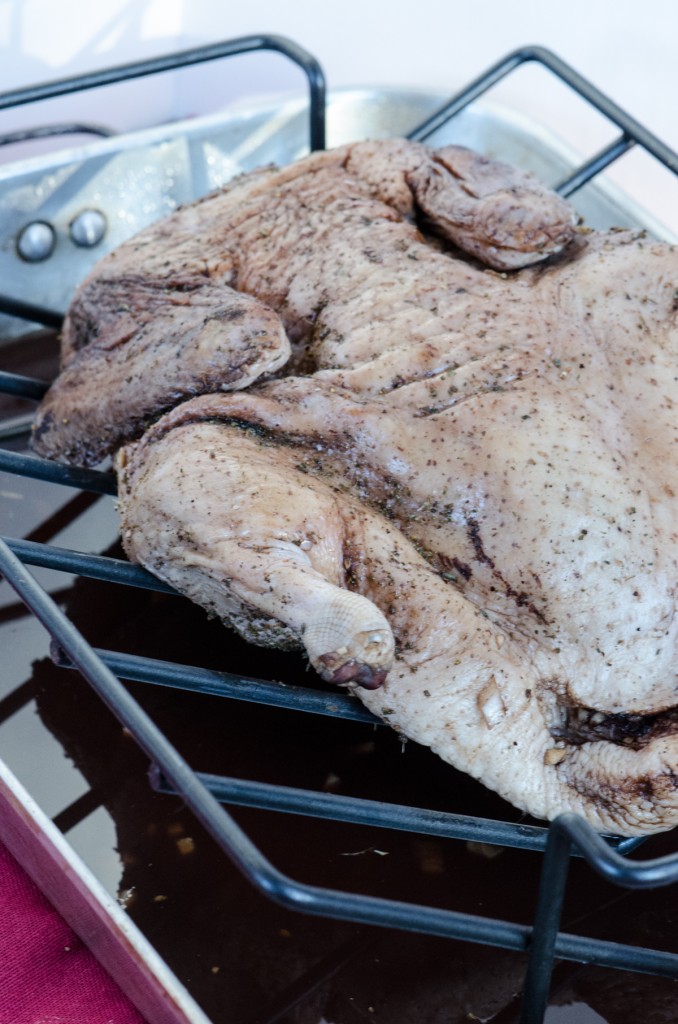 All along these waterways, we see the food products used in the local cuisine, from rice for risottos, to fresh-water fish, to waterfowl. Traditionally there was an enormous variety of water birds that were hunted and used for food. Each would be prepared in a particular way, designed to exhibit (or hide) its particular characteristics. Nowadays, we see recipes that call for “duck”, years ago, you would prepare each particular variety in a slight different way. The most prized species of duck “germano reale”, the familiar Mallard in english, even had different preparation techniques for the female (boiled, and used for stock) than the male (roasted). One would have then another specific recipe for the pintail duck, another for the teal, the tufted duck, the coot, and so forth. Waverly Root describes recipes in which the not-particularly attractive taste of heron and curlew is disguised with a lengthy marinade in white wine, lemon juice, consomme and herbs.
All along these waterways, we see the food products used in the local cuisine, from rice for risottos, to fresh-water fish, to waterfowl. Traditionally there was an enormous variety of water birds that were hunted and used for food. Each would be prepared in a particular way, designed to exhibit (or hide) its particular characteristics. Nowadays, we see recipes that call for “duck”, years ago, you would prepare each particular variety in a slight different way. The most prized species of duck “germano reale”, the familiar Mallard in english, even had different preparation techniques for the female (boiled, and used for stock) than the male (roasted). One would have then another specific recipe for the pintail duck, another for the teal, the tufted duck, the coot, and so forth. Waverly Root describes recipes in which the not-particularly attractive taste of heron and curlew is disguised with a lengthy marinade in white wine, lemon juice, consomme and herbs.
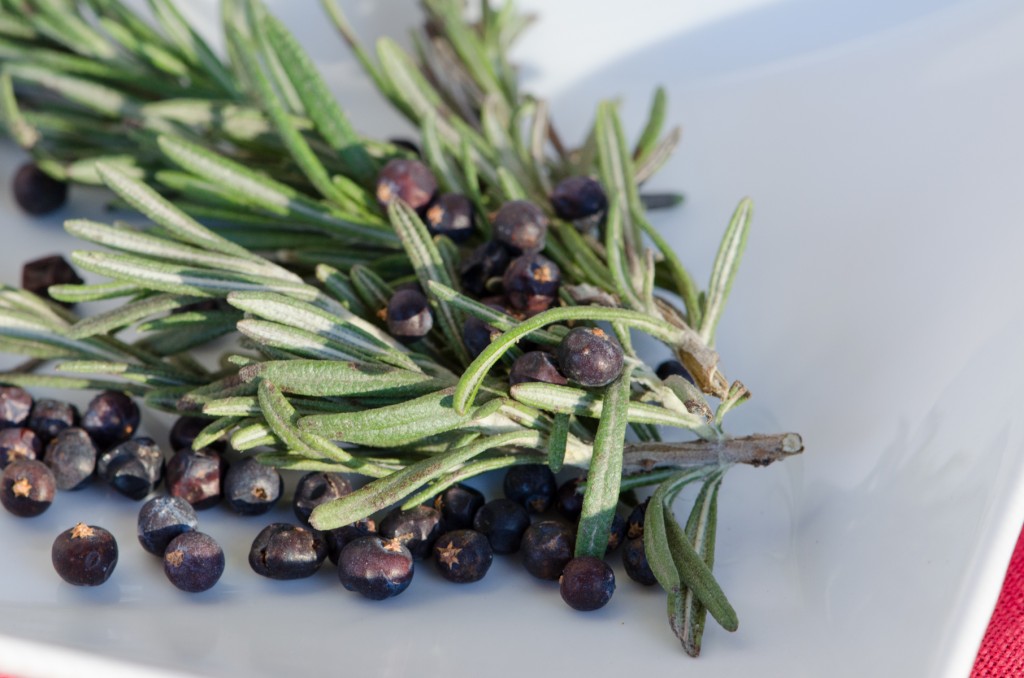 The varied assortment of wild species in the region is on the decline, due to pollution, shrinkage of wetlands due to agriculture and other development, unsustainable hunting, and invasive species, as the mallard is sometime considered to be due to the fact it can successfully interbreed with other wild species.
The varied assortment of wild species in the region is on the decline, due to pollution, shrinkage of wetlands due to agriculture and other development, unsustainable hunting, and invasive species, as the mallard is sometime considered to be due to the fact it can successfully interbreed with other wild species.
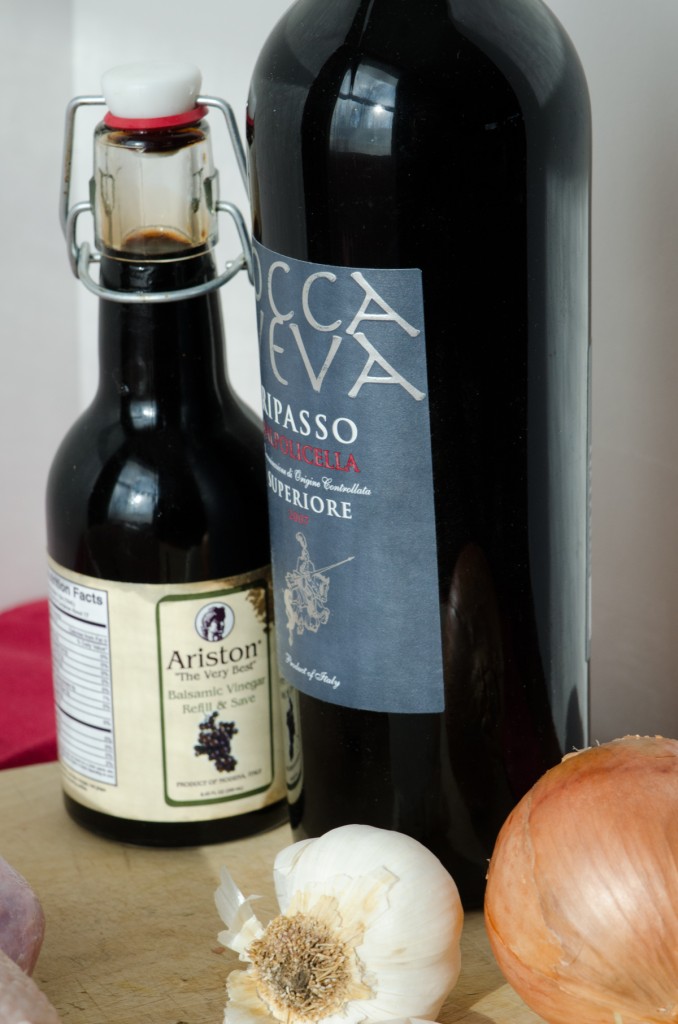 During the holiday season, it is easy to find fresh duck in my local grocery store; other times of year I only find frozen. Roasting duck is a bit more complicated than other fowl, due to it’s high fat content. The goal is to cook it slowly enough that the fat is rendered, but still get a crispy skin. I had several recipes I consulted for this recipe – one, from Marcella Hazan uses a blow dryer to dry the skin so it crisps up. Another, from Jody Adams, first roasts the duck, then cooks it again in a skillet. I’ve borrowed from both, working some of the flavors of Jody’s recipe into a marinade and spice rub and allowing the duck to sit, uncovered in the refrigerator in order to dry out the skin. This worked quite well, and the duck emerged nice and crispy from the oven. I served it with grilled polenta, but farro would be another great choice. Pair with a nice Valpolicella, and you’ve got a delicious and elegant holiday dinner.
During the holiday season, it is easy to find fresh duck in my local grocery store; other times of year I only find frozen. Roasting duck is a bit more complicated than other fowl, due to it’s high fat content. The goal is to cook it slowly enough that the fat is rendered, but still get a crispy skin. I had several recipes I consulted for this recipe – one, from Marcella Hazan uses a blow dryer to dry the skin so it crisps up. Another, from Jody Adams, first roasts the duck, then cooks it again in a skillet. I’ve borrowed from both, working some of the flavors of Jody’s recipe into a marinade and spice rub and allowing the duck to sit, uncovered in the refrigerator in order to dry out the skin. This worked quite well, and the duck emerged nice and crispy from the oven. I served it with grilled polenta, but farro would be another great choice. Pair with a nice Valpolicella, and you’ve got a delicious and elegant holiday dinner.
One fresh duck
1/2 cup balsamic vinegar
1/4 cup red wine
1/2 onion, chopped into 1/4 inch dice
2 garlic cloves, finely chopped
2 teaspoons dried rosemary
2 teaspoons ground juniper berries
1 tablespoon kosher salt
Remove the gizzards and other items from the cavity of the duck, reserving the gizzard and neck if you wish to make the sauce.
Cut off the wing tips, and reserve with the gizzard and neck for the sauce.
Cut off the fatty flaps around the neck opening and trim the fat from around the opening to the cavity. Discard the trimmings. Rinse the duck inside and out and pat dry. Carefully poke the skin of the bird all over with a fork or skewer. Try not to penetrate beyond the fat layer into the meat – if you poke in too far, the juices will run out during cooking along with the fat. Poking the skin at a sharp angle instead of straight in will help.
Mix the vinegar, red wine, onion and garlic cloves together in a large bowl. Roll the duck all around in the marinade, making sure plenty of marinade flows inside the cavity. Cover and marinate overnight in the refrigerator.
The next morning, remove the duck from the marinade (don’t scrape it off) and reserve the marinade in a small container. Mix together the rosemary, juniper berries, salt and pepper. Rub the spice mixture all over the duck, inside and out. Place the duck on a sheet pan and return to the refrigerator, uncovered, so the skin can dry out.
When ready to begin roasting, preheat the oven to 325°.
Set the marinated duck breast side down on a nonstick V-rack in a roasting pan. THe duck must be at least 2 inches above the bottom of the pan. Pour the remaining marinade into the pan, and add 1/4 inch of water. Place the pan in the oven and roast for 1 hour.
Flip the duck breast side up. Carefully prick the thighs with a fork again, avoiding penetrating the meat itself. Rotate the pan so the opposite side of the duck i now toward the back of the oven. Continue roasting until the skin is dark brown and just about all of the fat has melted off the body of the duck, another 2 to 2 1/2 hours. (This is a good time to make the sauce.)
The duck is done when an instant-read thermometer inserted into the thickest part of the thigh reads 180°. Let the duck rest 20 minutes.
When the duck is cool enough to handle, cut into 4 pieces, two breast and wing pieces, and two legs.
Heat a 1/8-inch layer of vegetable oil in a large, heavy bottomed saute pan over high heat until very hot. A nonstick pan is preferable. Season the duck pieces with salt and pepper. When the oil is almost smoking, add the duck pieces skin side down Do not disturb the duck pieces once you have set them in the pan. Allow them to sear for 1 minutes, then adjust the heat to low, cover the pan and cook until the skin is crisp, about 15 minutes. Pour off any excess fat that accumulates. Sprinkle the meat side with balsamic vinegar.
Balsamic Vinegar Sauce
Wing tips, neck, and gizzard from 1 duck
2 tablespoons vegetable oil
2 shallots, coarsely chopped
1/2 small carrot, peeled and coarsely chopped
1/2 celery stalk, coarsely chopped
1/2 teaspoon chopped fresh thyme
1/2 teaspoon fresh rosemary
1/2 cup dry white wine
2 cups chicken broth
Kosher salt and freshly ground black pepper
1 teaspoon ground juniper berries
1 to 2 tablespoons balsamic vinegar
Using a cleaver or large kitchen shears, chop the wing tips and neck into 3 inch pieces. Coarsely chop the gizzard. Heat the vegetable oil in a large sauté pan over high heat. Add the chopped wing and neck pieces. Cook until well-browned, 8 to 10 minutes. Pour off any excess fat. Add the gizzard, shallots, carrots, and celery. Cook until well browned, about 5 minutes.
Lower the heat to medium. Add the herbs and wine and reduce to a glaze, 5 to 7 minutes. Add the chicken stock and reduce until the sauce coats the back of a spoon, about 25 minutes. Strain. Season to taste with salt, pepper, juniper berries and the balsamic vinegar. Serve warm.
Lenticchie – Lentils, and 5 (or more) Different Ways to Use Them
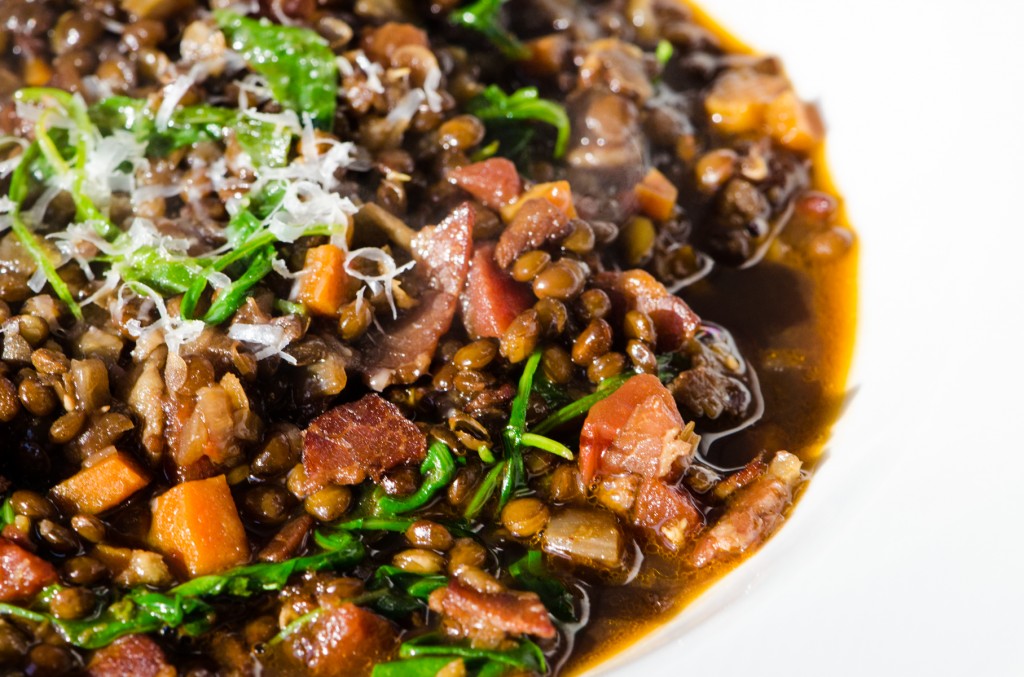 Ski season will soon be upon us, and I’m craving warm comfort food with the onset of cold temperatures. A warm meal in a mountain rifugio is a perfect mid-day break during our Dolomite ski holidays. But comfort food does not have to mean unhealthy; the right recipes can combine a wide variety of good-for-you foods into a warm and wonderful dish.
Ski season will soon be upon us, and I’m craving warm comfort food with the onset of cold temperatures. A warm meal in a mountain rifugio is a perfect mid-day break during our Dolomite ski holidays. But comfort food does not have to mean unhealthy; the right recipes can combine a wide variety of good-for-you foods into a warm and wonderful dish.
This post is about one of my favorite healthy foods – lentils. Lentils are legumes, not beans, and don’t require the pre-soaking that dried beans do. I can keep lentils in the cupboard, pull them out, and have a great soup in about an hour.
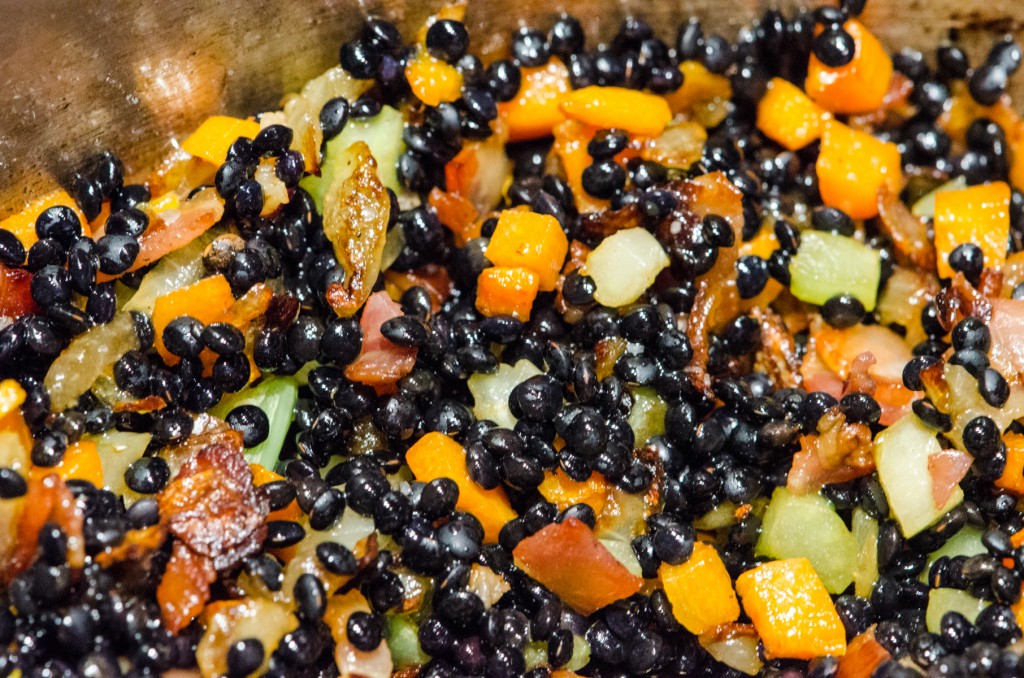 Lentils are the lens-shaped seeds of a bushy annual plant of the legume family. They are eaten throughout the world, and have been part of our diet since ancient times. Lentils are commonly used in soups in Europe, North and South America, and often combined with rice in Western Asia and the Mid East.
Lentils are the lens-shaped seeds of a bushy annual plant of the legume family. They are eaten throughout the world, and have been part of our diet since ancient times. Lentils are commonly used in soups in Europe, North and South America, and often combined with rice in Western Asia and the Mid East.
In Italy, there are a couple of basic lentil recipes that you’ll find in many regions of Italy. Lentils and sausage are favorite combination in Umbria and Tuscany. Lentils are stewed in tomato sauce and broth in Emilia Romagna, where they are often served along with sausage on New Year’s Day, as eating lentils to welcome the new year is believed to bring luck – their coin-like shaped predicting future wealth.
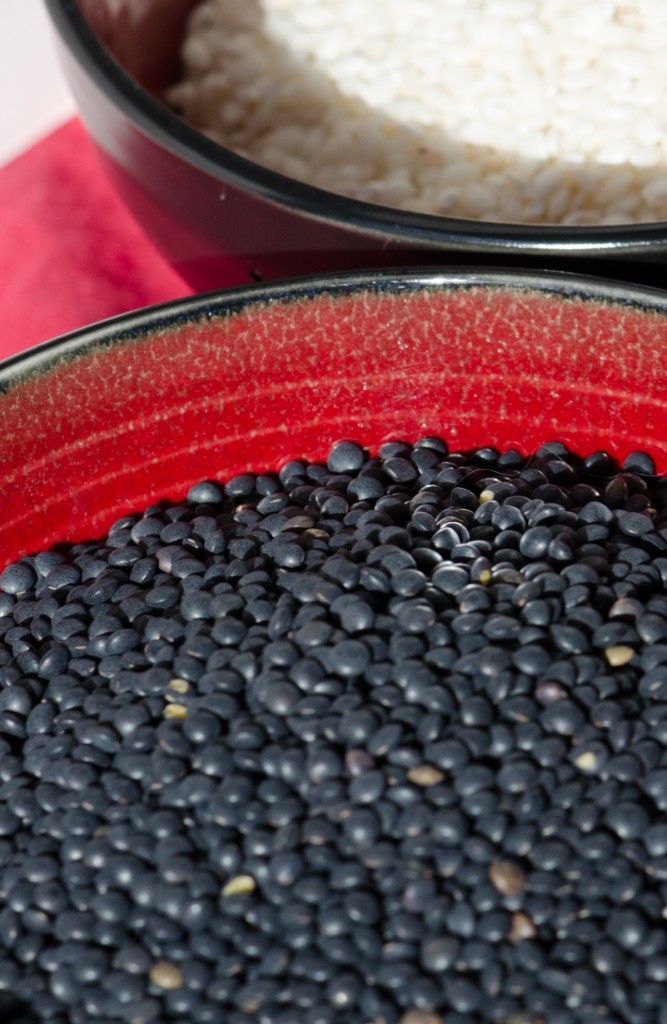 Eating lentils brings good fortune any time of year, as they are extremely nutritious. With about 30% of their calories from protein, lentils have the third-highest level of protein, by weight, of any legume or nut, after soybeans and hemp. Lentils are an essential source of inexpensive protein in many parts of the world, especially in areas which have large vegetarian populations. Lentils also contain dietary fiber, folate, vitamin B1, and minerals.
Eating lentils brings good fortune any time of year, as they are extremely nutritious. With about 30% of their calories from protein, lentils have the third-highest level of protein, by weight, of any legume or nut, after soybeans and hemp. Lentils are an essential source of inexpensive protein in many parts of the world, especially in areas which have large vegetarian populations. Lentils also contain dietary fiber, folate, vitamin B1, and minerals.
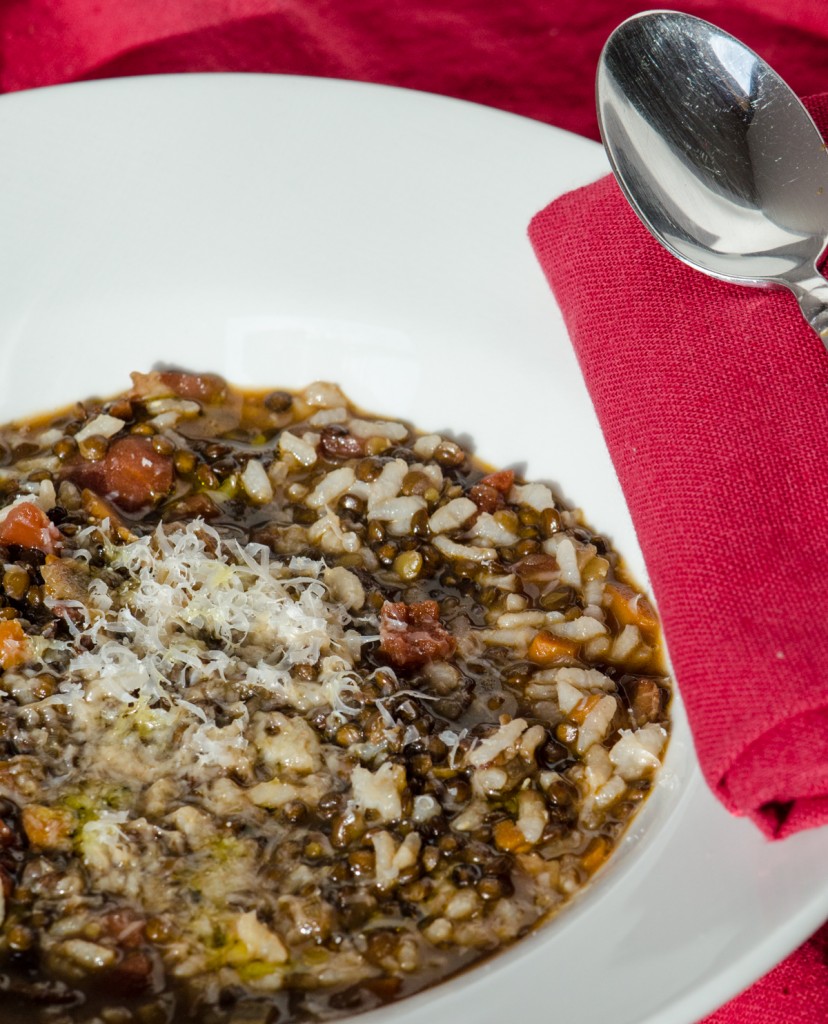 As I sat down to write up this post, I was following an on-line discussion on how to eat healthy meals during our busy day-to-day lives. It is tough to bypass easy to grab processed foods, but with a little bit of planning when you do have a chance to cook, you can prepare the pieces for several healthy meals. So I thought I’d share how I take a basic Italian lentil recipe and turn it into several variations I can enjoy throughout a busy week. When I am overloaded on lentils, I take any leftovers and pack them in small resealable sandwich bags and pop them in the freezer for future use.
As I sat down to write up this post, I was following an on-line discussion on how to eat healthy meals during our busy day-to-day lives. It is tough to bypass easy to grab processed foods, but with a little bit of planning when you do have a chance to cook, you can prepare the pieces for several healthy meals. So I thought I’d share how I take a basic Italian lentil recipe and turn it into several variations I can enjoy throughout a busy week. When I am overloaded on lentils, I take any leftovers and pack them in small resealable sandwich bags and pop them in the freezer for future use.
Lenticchie
3 tablespoons extra virgin olive oil
1 small onion, chopped into 1/4 inch dice
4 ounces pancetta, chopped
1 carrot, cut into 1/4 inch dice
1 stalk celery, peeled and cut into 1/4 inch dice
Kosher salt and freshly ground pepper
1 cup canned plum tomatoes, cut into 1/4 inch dice
1/2 pound (about 1 1/4 cups) dried lentils, rinsed
3 cups beef or chicken broth
Pour olive oil into a soup pot and heat over medium high heat. Add the onion and pancetta and cook, stirring occasionally, until golden brown.
Add the carrot and celery. Cook for 3 minutes, until beginning to become soft. Season with salt and pepper.
Add the tomatoes and lentils to the pot, stirring well. Add the broth. Bring to a simmer, then reduce heat to a gentle simmer and cover, stirring from time to time, and cook until the lentils are tender, but not mushy. Lentils vary greatly in cooking time, from 10 minutes to 45 minutes, depending upon the type and if the hull has been removed, so rely on taste rather than time. If needed, add more broth or water.
- Now that you have a delicious batch of lentils, you can serve it as a side to sausages, as they do in Italy – see my post on Lenticchie con Salsiccia.
- Puree the lentils, and serve as a side with fish – it goes wonderfully with trout.
- Leave out the pancetta, and combine the lentils with rice for a great vegetarian dish.
- Add a bit more broth, and you have lentil soup. If you prefer a creamier soup, puree briefly with an immersion blender. Or puree until totally smooth. Add some great Greek yogurt for a tang
- Add lentils to a green salad. Smoked trout would be a great addition for some additional protein.
There are many variations of lentil soups in Italy – here are just a few:
- Add some leftover pasta
- Add leftover risotto (gluten free)
- Add some sautéed greens – kale, arugula, escarole
- Top with toasted bread (crostini), rubbed with a garlic clove and drizzled with olive oil.
A Perfect Pairing for Thanksgiving – Pumpkin Soup and Branko Wines
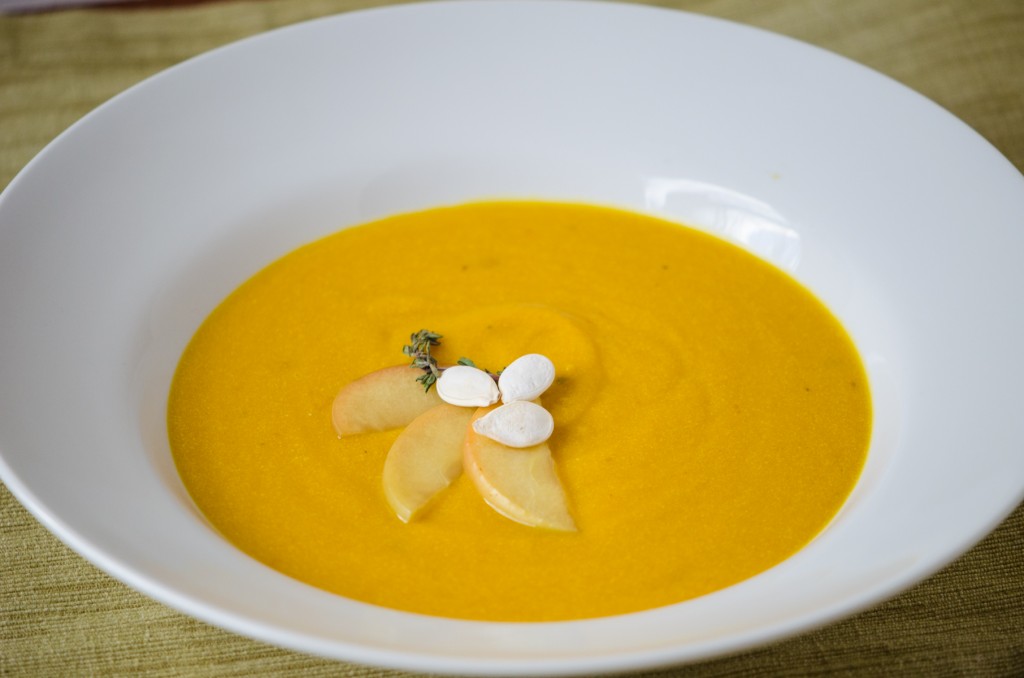 On a past visit to Italy, I spent some time visiting Cormons, Italy, in the region of Fruili Venezia Giulia. Located in the north easternmost corner of Italy, right next to Slovenia, this relatively unknown region produces some of the best wines in Italy. Wonderful wines, and cycling route options from flatter coastal rides to some of the most challenging climbs in Italy make it a great destination for our Italiaoutdoors bike tours. The enoteca in Cormons is a perfect one-stop shop to try out some of the best wines from the Collio wine zones.
On a past visit to Italy, I spent some time visiting Cormons, Italy, in the region of Fruili Venezia Giulia. Located in the north easternmost corner of Italy, right next to Slovenia, this relatively unknown region produces some of the best wines in Italy. Wonderful wines, and cycling route options from flatter coastal rides to some of the most challenging climbs in Italy make it a great destination for our Italiaoutdoors bike tours. The enoteca in Cormons is a perfect one-stop shop to try out some of the best wines from the Collio wine zones.
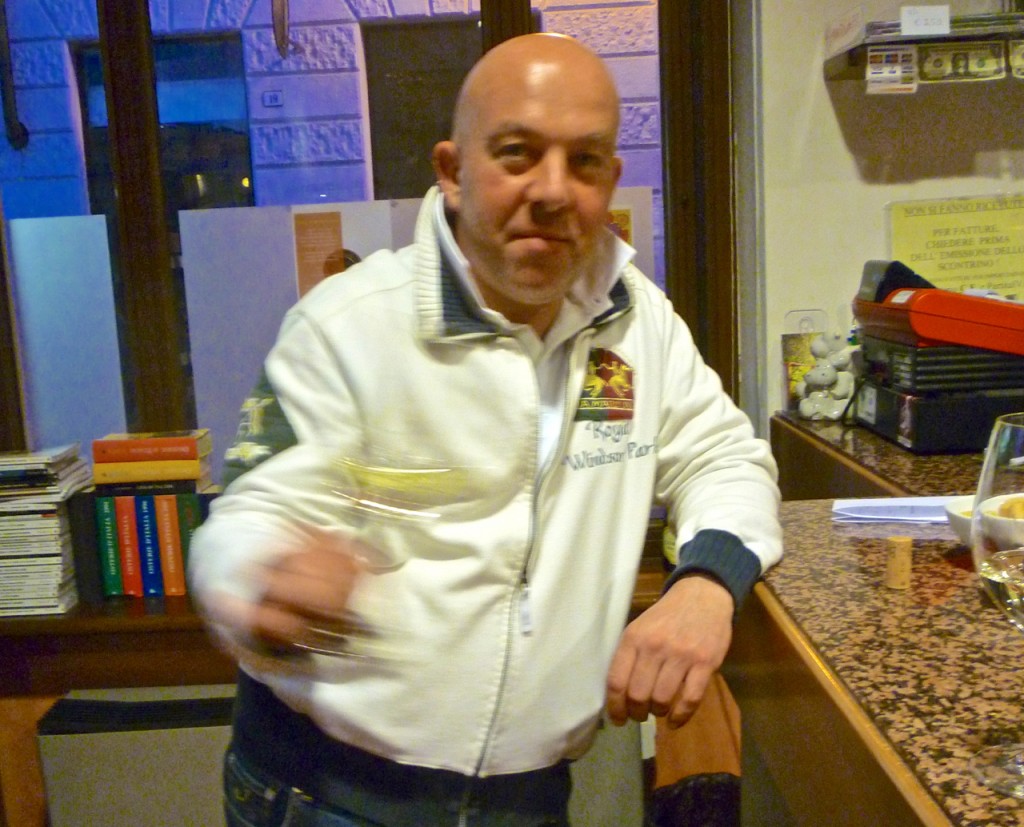 After a few hours touring the area, I stopped by the enoteca. As I was enjoying a few sips of a Magnas Friulano, I noticed the other two gentleman patrons were tasting the Branko Pinot Grigio, a wine I had discovered in the US and found very nice. I commented on how much I like the Branko wine, and to my surprise found that I was talking with Igor Erzetic, the winemaker himself! After explaining my interest in the region and it’s wines, Igor and his friend took it upon themselves to give me a thorough introduction to many of the best wines the the area. What followed was almost a blur of wines, and the two gentlemen and the proprietor placed wine after wine in front of me. At the end of the evening, we exchanged contact information and I suggested he contact me if he were ever in the Boston area promoting his wines.
After a few hours touring the area, I stopped by the enoteca. As I was enjoying a few sips of a Magnas Friulano, I noticed the other two gentleman patrons were tasting the Branko Pinot Grigio, a wine I had discovered in the US and found very nice. I commented on how much I like the Branko wine, and to my surprise found that I was talking with Igor Erzetic, the winemaker himself! After explaining my interest in the region and it’s wines, Igor and his friend took it upon themselves to give me a thorough introduction to many of the best wines the the area. What followed was almost a blur of wines, and the two gentlemen and the proprietor placed wine after wine in front of me. At the end of the evening, we exchanged contact information and I suggested he contact me if he were ever in the Boston area promoting his wines.
Almost 2 years later, Igor’s representatives contacted me, and with lots of help from his local importer, Masciarelli Wines, and my very good friends at TRADE restaurant in Boston, we held a wine dinner last Monday at TRADE. Chef Andrew Hebert designed a fantastic fall menu, with dishes specifically created to match the Branko wines. For those interested in purchasing Branko wines in the Boston area, scroll to the end of this post for local outlets.
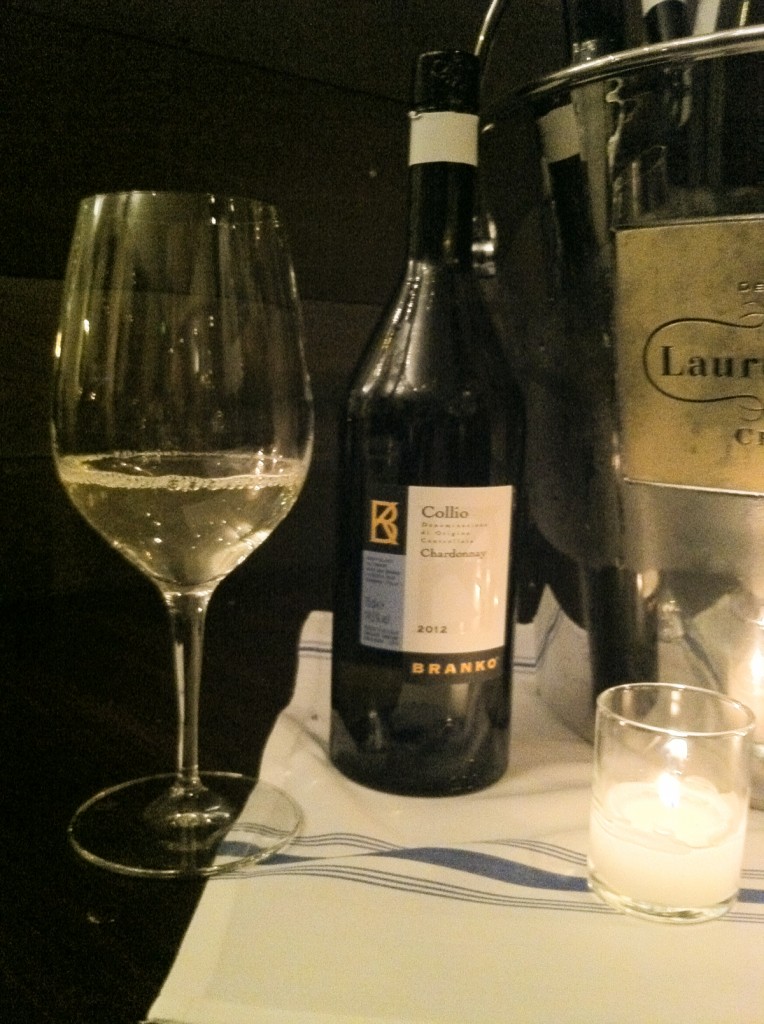
We began with the evening with the Branko Chardonnay. The Erzetic family has been cultivating grapes and producing wines in the Collio region for many years. Branko Erzetic restored the terraced vineyards with his then teenage son, Igor. Today, Igor runs the operation. The Branko Chardonnay is wonderful example of how flavorful and refreshing a chardonnay can be, especially when the oak is used to enhance the grapes, rather than overwhelm. Igor brings out the best in his Chardonnay by fermenting and maturing about 30% of the wine in mid-sized oak containers. We had a discussion about this tendency of some producers, especially in the US, to over-oak their chardonnays, something I have never been a big fan of. The Branko Chardonnay has a very pleasant bouquet with floral notes, pear, apple, and just a hint of oak. Crisp and refreshing, this is a wine to introduce to your friend who has sworn off this grape after one too many glasses of the oaky, buttery versions. The first course, created to accompany the Chardonnay was a ripe avocado served with a peanut-tamarind chutney, mango and cilantro.
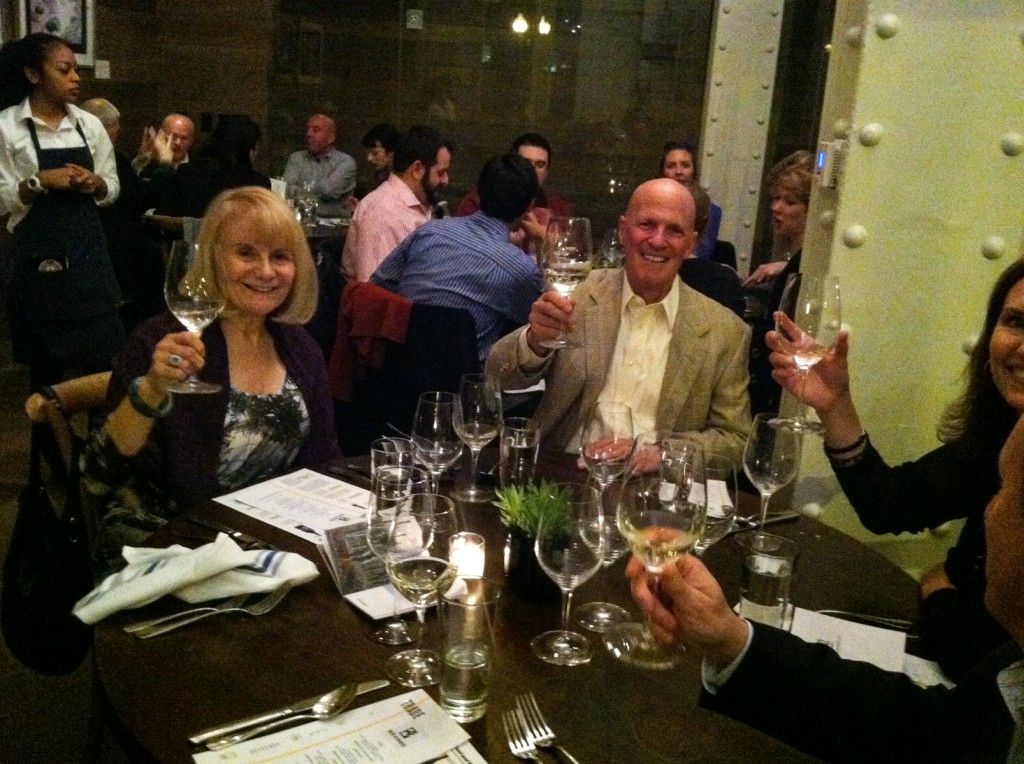
Next, the traditional Friuli white varietal, Friulano. Formerly known as Tocai, the name was changed to avoid confusion with the Hungarian varietal Tokay, you can often still find it served under its former name. Friulano is very aromatic, with hints of bitter almond amongst floral notes. Again, Igor ages a small proportion of the Friulano grapes in oak, to enhance the naturally fresh-tasting palate. Overheard among the guests – “This is a great wine for turkey – something memorable to serve at Thanksgiving, rather than just another white.” We enjoyed a Pumpkin Soup with pickled apples and toasted pumpkin seeds with the Friulano – I’ve included a recipe for this dish below, a traditional Friuli recipe that I’ve altered a bit.
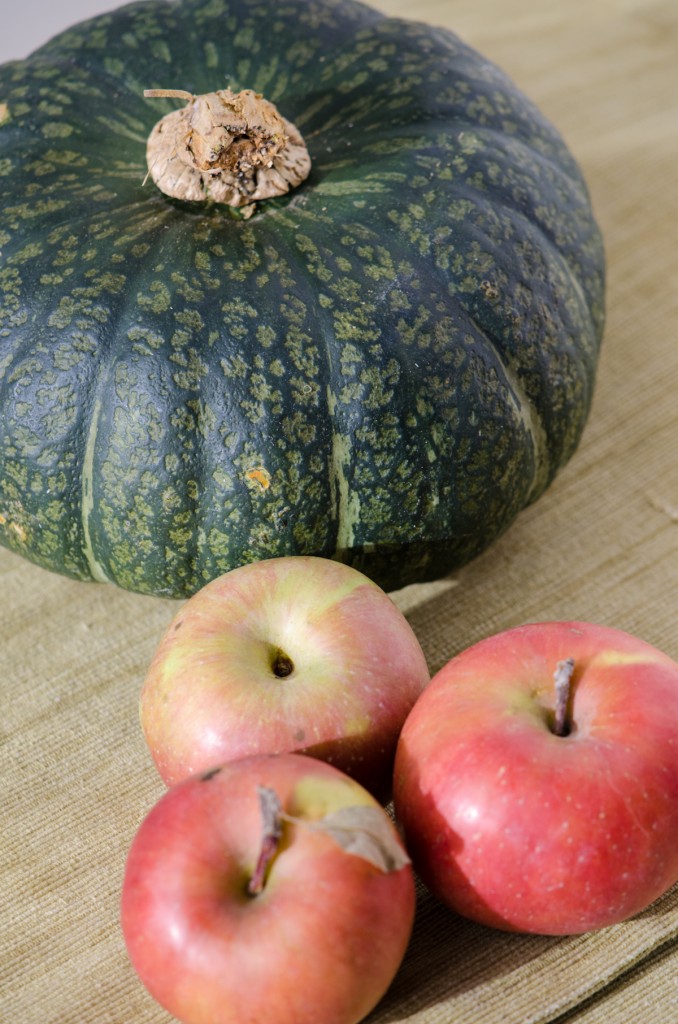
Next, the Branko Pinot Grigio. This is Branko’s flagship wine, and a regular contender at Gambero Rosso’s Three Glass finals. This wine has walked away with the prestigious ‘tre bicchieri’ award on numerous occasions, earning a reputation for a top notch example of this varietal. For those of you who view Pinot Grigio as a rather uninteresting wine, this will be an eye-opener. Full-flavored and intense, hints of ginger give this a spiciness that is balanced with velvety flavors of pear and almond, and just a hint of oak. It manages to be both complex and refreshing at the same time, and is now one of my favorite Pinot Grigio wines. A wonderful, flavorful wine that pairs well with an antipasti of speck and local cheeses, poultry, or seafood – we enjoyed it with Grilled squid and fried tentacles with vinegar peppers, bean salad and olives.
Our last course, a Crispy pork shoulder with polenta, fennel, apples and grapes, was served with the one red wine in the Branko portfolio, a Cabernet Merlot blend. A fresh, young, fruity wine with a bit of softness and elegance from a brief aging in wood. Flavors of dark forest berries and cherries combine to produce an elegant, structured palate that can be enjoyed both young and after a bit of time in the cellar.
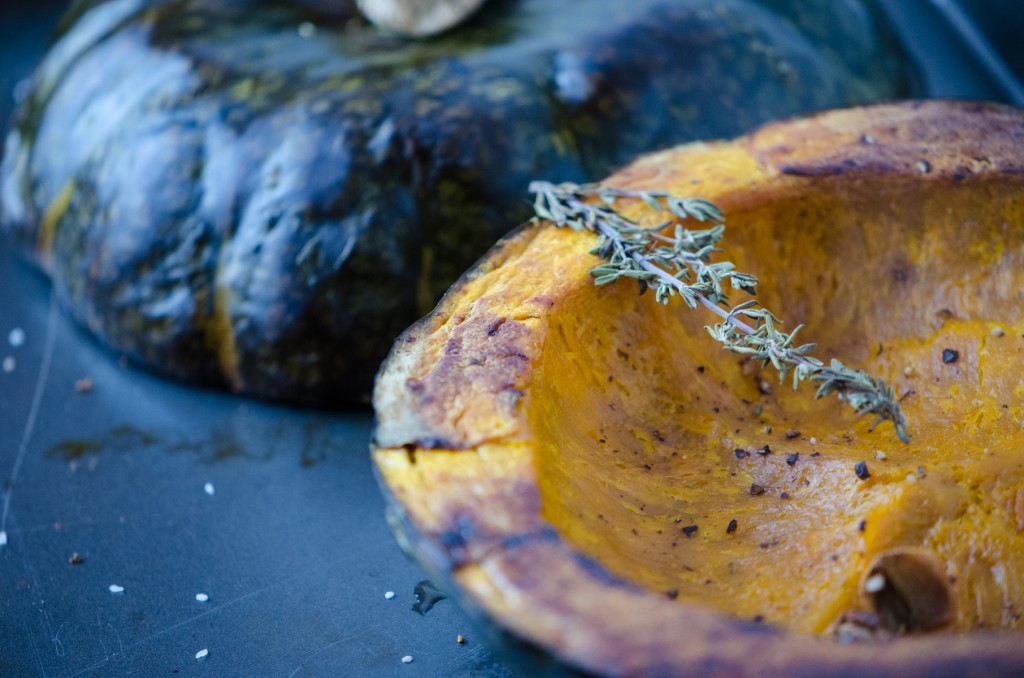
As promised, here is my version of a traditional pumpkin soup from Friuli Venezia Giulia. A great Thanksgiving first course, to be enjoyed with the Branko Friulano.
Pumpkin Soup with Pickled Apples
1 small pumpkin or large winter squash
Extra virgin olive oil
Kosher salt and freshly ground pepper
2 sprigs thyme
4 cloves garlic
1 cup ricotta cheese
2 cups apple cider
2 cups water
Pickled apples
Roasted pumpkin seeds
Preheat the oven to 350°.
Split the pumpkin and scrape out the seeds and pith, oil the cut surfaces with olive oil, and season generously with salt and pepper. Place the halves cut side down on a baking sheet, with a sprig of thyme and 2 cloves of garlic, tucked underneath each seed cavity. Roast in the oven for 45 minutes, or until completely tender. When the pumpkin is cool enough to handle, scoop out the flesh (or peel off the skins) and add the pulp to a soup pot along with the roasted garlic and ricotta cheese. Mash them together with a potato masher or spoon; add the cider and water, and heat to a simmer. Taste and correct the seasoning. Serve, garnished with a few slices of pickled apple and a few roasted pumpkin seeds.
Pickled Apples
2 small apples
1/2 cup cider vinegar
1 cup apple cider
Cut the apples into quarters, then cut out the core. Place the apple quarters skin side up on a cutting board and cut into thin slices.
Combine the vinegar and cider in a non-reactive sauce pan. Bring to a boil. Add the apple slices and remove from heat. Let sit for at least one hour.
Where to purchase Branko wines in Boston area. If any of these don’t carry them, they will be happy to order them for you.
Downtown:
Federal Wine and Spirits
Boston Wine Exchange
BRIX
Bacco’s
South End:
BRIX
Urban Grape
West Suburbs:
Urban Grape (Chestnut hill)
Spirited Gourmet (Belmont)
Concord Wine & Spirits
North Suburbs:
Henry’s (Beverly)
Pairings (Winchester)
Leary’s (Newburyport)
Barbabietole al Forno – Roasted Beets, 3 Ways
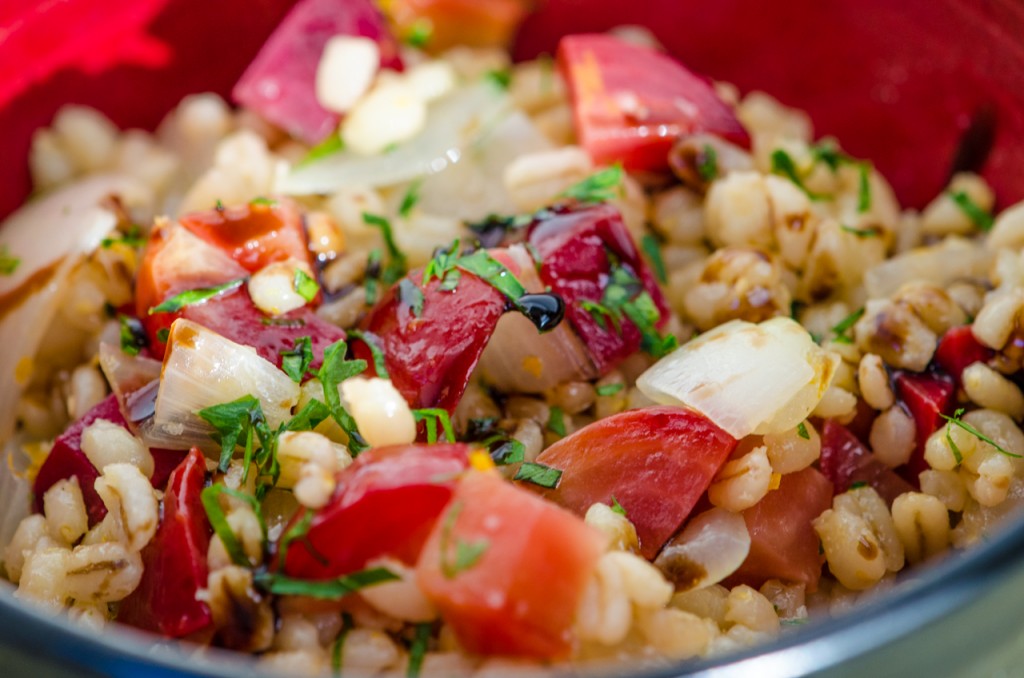 Finding Chioggia beets at my grocers always brings me immediately back to Italy. This heirloom beet comes from the Italian coastal town of Chioggia, right across the lagoon from Venice. In fact, it is often referred to as “Little Venice”, and a nice stop on our Italy bike tours as we explore the Lido and islands off of Venice.
Finding Chioggia beets at my grocers always brings me immediately back to Italy. This heirloom beet comes from the Italian coastal town of Chioggia, right across the lagoon from Venice. In fact, it is often referred to as “Little Venice”, and a nice stop on our Italy bike tours as we explore the Lido and islands off of Venice.
 This beet varietal was probably brought to the US in the 1800s by Italian immigrants. Chioggia is a coastal town, which would not have been my first guess as to the birthplace of beets. It ends up that all beets (barbabietole in Italian) – and this includes members of the beet family grown for their leaves, such as chard (bietole), as well as those grown for their tubers – are descendants of the sea beet. The sea beet is native to the coasts of Europe, northern Africa and southern Asia. It requires moist, well-drained soils, and does not like shade. It is able to tolerate relatively high levels of sodium in its environment because its leaves are waxy, hence its ability to thrive in coastal areas.
This beet varietal was probably brought to the US in the 1800s by Italian immigrants. Chioggia is a coastal town, which would not have been my first guess as to the birthplace of beets. It ends up that all beets (barbabietole in Italian) – and this includes members of the beet family grown for their leaves, such as chard (bietole), as well as those grown for their tubers – are descendants of the sea beet. The sea beet is native to the coasts of Europe, northern Africa and southern Asia. It requires moist, well-drained soils, and does not like shade. It is able to tolerate relatively high levels of sodium in its environment because its leaves are waxy, hence its ability to thrive in coastal areas.
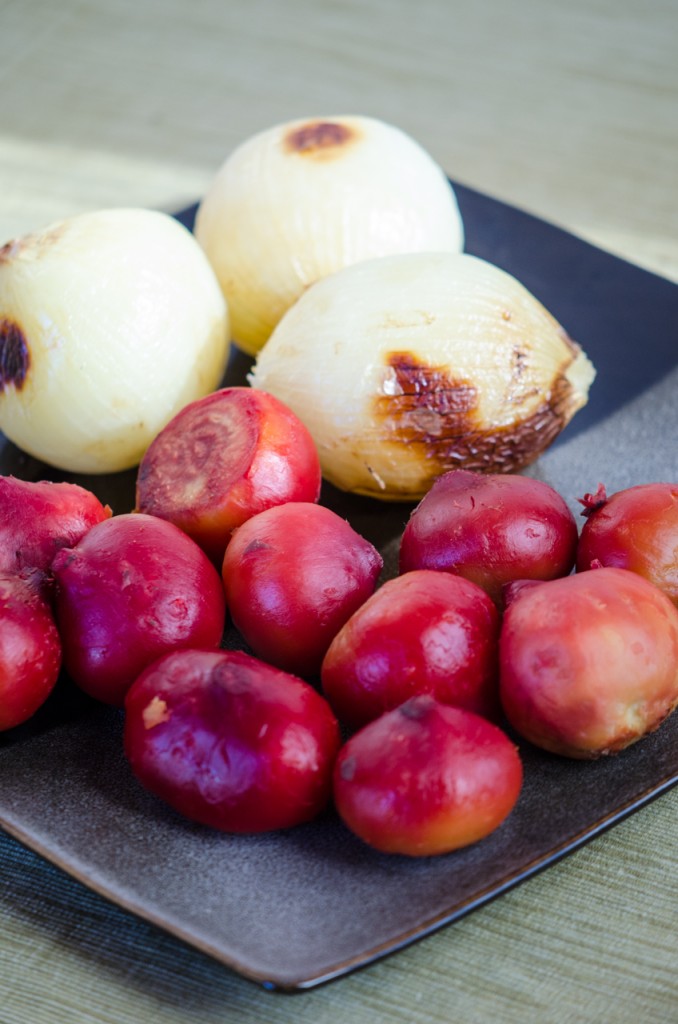 Beets can be enjoyed many ways; raw, pickled, boiled, steamed, but the several cookbooks I referenced for this post all agreed that roasting or baking was the way to go. To quote Marcella Hazan, “The very best way to cook beets is to bake them. It concentrates their flavor to an intense, mouth-filling sweetness that is to swoon over if you have never had them before. No other method compares favorably with baking…”
Beets can be enjoyed many ways; raw, pickled, boiled, steamed, but the several cookbooks I referenced for this post all agreed that roasting or baking was the way to go. To quote Marcella Hazan, “The very best way to cook beets is to bake them. It concentrates their flavor to an intense, mouth-filling sweetness that is to swoon over if you have never had them before. No other method compares favorably with baking…”
Alice Waters says “In general, we prefer to roast beets until tender rather than boiling them, because they loose less flavor (and color).”
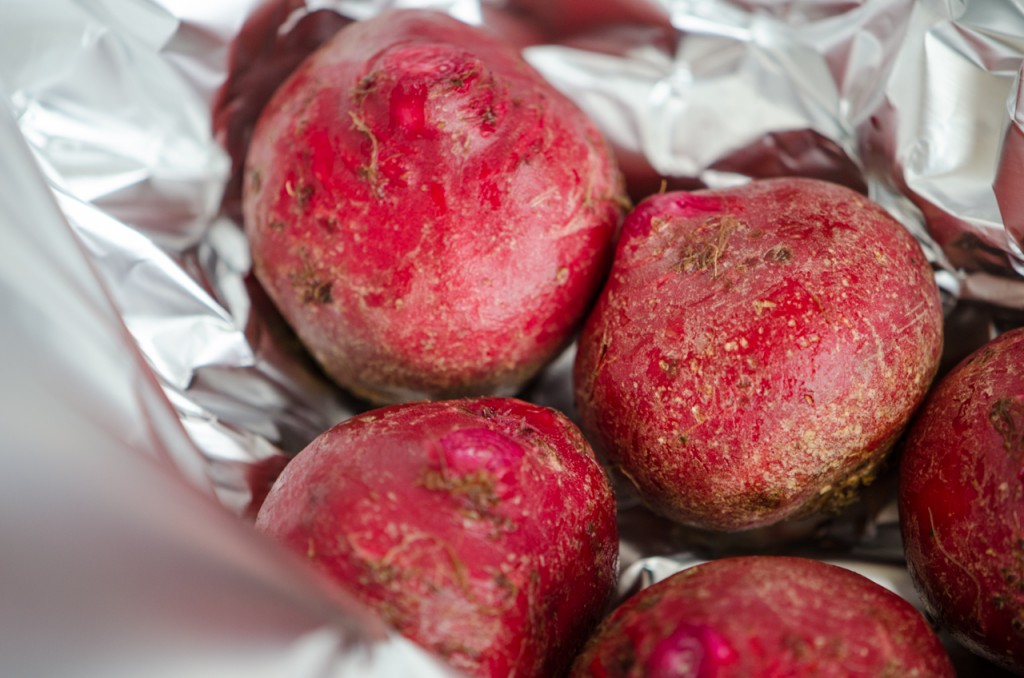 Here are a few beet recipes of Italian origin. A simple recipe for roasting them, which can be used in a variety of ways.
Here are a few beet recipes of Italian origin. A simple recipe for roasting them, which can be used in a variety of ways.
Barbabietole e Cipolle al Forno (Roasted Beets and Onions)
Adapted from recipes in Lynn Rosetto Kasper’s “The Splendid Table”, and Marcella Hazan’s “Essentials of Classic Italian Cooking”
1 large bunch beets
3 medium onions, unpeeled
Preheat the oven to 400°.
Cut off the tops of the beets at the base of the stems and save to cook later. Trim the root ends of the beet bulbs. Wash the beets in cold water, then wrap them all together, or in two packets of aluminum foil, crimping the edge of the foil to seal tightly. Put them on a sheet pan with the onions.
Place the sheet pan in the upper part of the oven. They are done when they feel tender but firm when tested with a knife, about 1 to 1 1/2 hours, depending on their size.
While they are still warm, but cool enough to handle, pull off their skin. Trim away the onion skins.
For a vegetable side dish:
Cut the beets and onions into wedges. Season with salt and pepper and drizzle with a balsamic vinegar and serve.
Insalata con Barbabietole e Cipolle al Forno
Roasted beets and onions
Romaine lettuce
1/4 cup toasted walnuts, coarsely chopped
4 tablespoons extra virgin olive oil
3 tablespoons balsamic vinegar
Kosher salt and freshly ground pepper
Serve as a salad by arranging the cut onions and beets on a bed of romaine leaves. Top with the toasted walnuts. Sprinkle the salad with the olive oil and balsamic vinegar. Season with salt and pepper.
Any leftovers can be used in this version of a barley salad from the region of Friuli Venezia Giulia (another great spot for exploring on a bike tour), adapted from Fred Plotkin’s “La Terra Fortunata”. In Italy, orzo is not a rice shaped pasta, but the grain barley.
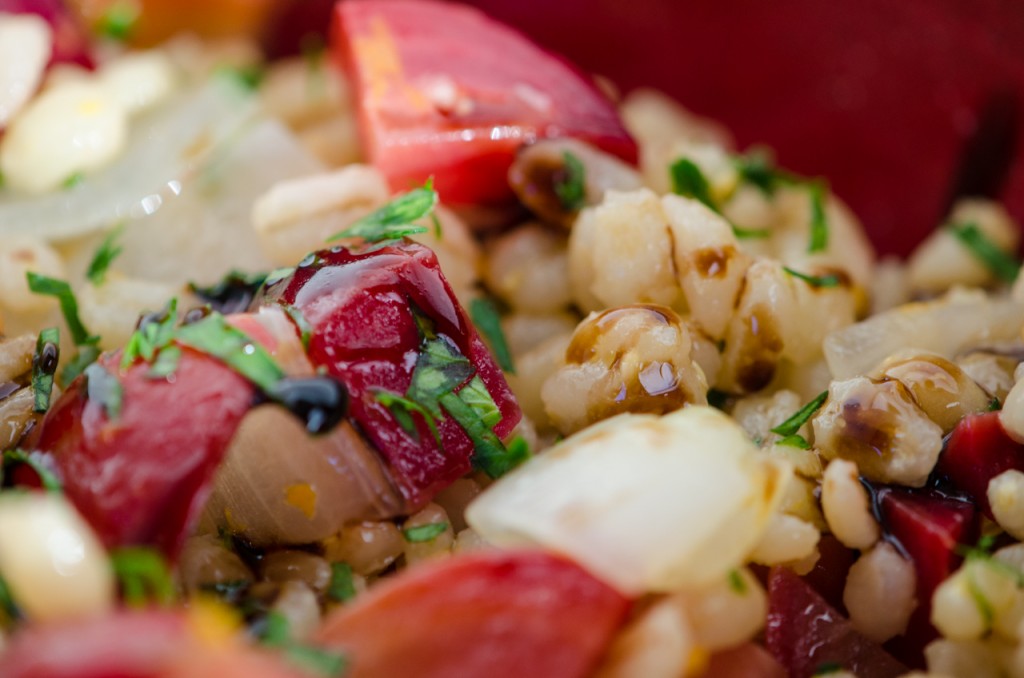 Orzo con le Barbabietole (Barley with Beets)
Orzo con le Barbabietole (Barley with Beets)
1 cup pearl barley
2 1/2 cups chicken stock (or water)
1 – 4 roasted beets (depending upon size), cut into 1/2 inch dice
1 roasted onion, cut into 1/2 inch dice
2 tablespoons extra virgin olive oil
Zest of 1 orange
2 tablespoons chopped parsley
Kosher salt and freshly ground pepper
Balsamic glaze
Rinse the barley under cold running water. Place in a large pot, add the chicken stock or water, and bring to a boil. Reduce heat to low, cover, and cook for 35 to 40 minutes, until the barley is tender. The actual amount of time will depend on how much the barley is ‘pearled’, or processed. Check, as more liquid may be needed.
Add the beets, onions, olive oil, zest, and parsley to the warm barley. Stir to combine, and season to taste with salt and pepper. Warm a bit over low heat if the beet and onions were cold. Serve, garnished with a bit more parsley and balsamic glaze.
